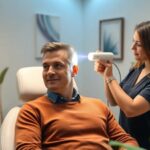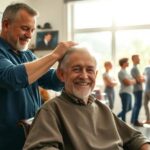Alopecia areata is a complex autoimmune condition that leads to hair loss. Understanding treatment options is crucial for those affected, as various therapies can promote hair regrowth. Among these options, topical steroids play a key role in managing this condition.
In this article, we will explore the use of topical steroids, their effectiveness, potential side effects, and other therapeutic alternatives for alopecia areata.
What are the best topical steroids for alopecia areata?
When considering treatment for alopecia areata, topical corticosteroids are often among the first-line options. Some of the best topical steroids for this condition include:
- Clobetasol Propionate: A high-potency steroid known for its efficacy.
- Triamcinolone: Frequently used in various formulations.
- Betamethasone: Often recommended for its strong anti-inflammatory properties.
- Hydrocortisone: A milder option that can be suitable for sensitive areas.
Each of these corticosteroids has unique properties that can be beneficial depending on the severity of the condition and the patient's age. For example, clobetasol propionate has demonstrated significant results, especially in pediatric cases, promoting impressive hair regrowth.
It's important to consult with a healthcare provider to determine which topical steroid might be the best fit for you.
Are topical steroids used for alopecia areata?
Yes, topical steroids are widely used for alopecia areata. The primary purpose of these medications is to reduce inflammation and suppress the immune response that contributes to hair loss.
Topical corticosteroids are particularly effective in treating localized areas of hair loss. They can:
- Help in regrowing hair by reducing inflammation.
- Provide a non-invasive treatment option for those hesitant about injections.
- Be used in conjunction with other therapies for enhanced effectiveness.
However, the effectiveness can vary. Some patients may experience noticeable improvements, while others might not see the same level of success. It’s essential to set realistic expectations and understand that the journey to hair regrowth can be different for everyone.
You may be interested in reading: Can cold laser therapy regrow hair?
Can cold laser therapy regrow hair?What is the effectiveness of clobetasol propionate for alopecia areata?
Clobetasol propionate is considered one of the most effective topical steroids for treating alopecia areata. Studies indicate that it can significantly enhance hair regrowth, especially in patients with a limited extent of hair loss.
The effectiveness of clobetasol propionate can be attributed to its high potency, which allows for deeper penetration into the skin. This is particularly beneficial in targeting the inflammatory processes associated with alopecia areata.
In addition to its efficacy, clobetasol is generally well-tolerated, although some patients might experience mild skin irritation. Regular follow-ups with a healthcare provider can help monitor for any adverse effects during treatment.
How does triamcinolone cream work for alopecia areata?
Triamcinolone cream is another viable option for those dealing with alopecia areata. This corticosteroid works by acting on the inflammatory pathways, thus reducing the autoimmune response that leads to hair follicle damage.
Patients using triamcinolone may experience:
- Reduction in inflammation around hair follicles.
- Potential improvement in hair density and growth.
- Application convenience, as it is available in various formulations.
The cream's effectiveness can vary, and results can take time to manifest. Typically, a duration of several weeks of consistent application is necessary to observe any substantial changes in hair regrowth.
What are the side effects of topical corticosteroids for alopecia areata?
While topical corticosteroids can be effective, they are not without their potential side effects. Common side effects include:
- Skin thinning or atrophy.
- Stretch marks in the treated area.
- Increased risk of skin infections.
Long-term use or overapplication of high-potency steroids can exacerbate these issues. Patients are advised to follow their prescribed regimen closely and report any adverse effects to their healthcare provider promptly.
You may be interested in reading: Is male-pattern baldness treatable after 60?
Is male-pattern baldness treatable after 60?It's essential to weigh the benefits against the risks and to use these medications as directed.
What is the recommended oral prednisone dose for alopecia areata?
In some cases, oral prednisone is prescribed to manage more extensive or severe cases of alopecia areata. The recommended dose can vary significantly based on individual circumstances.
Typically, the initial dose may range from:
- 20 to 60 mg daily, depending on the severity of the condition.
- Gradual tapering is usually recommended to minimize side effects.
Patients should not self-medicate or adjust their dosage without consulting their healthcare provider. Monitoring is crucial to ensure both efficacy and safety during treatment.
How effective is hydrocortisone cream for alopecia areata?
Hydrocortisone cream is a lower-potency topical steroid often used for mild cases of alopecia areata. While it may not be as effective as stronger corticosteroids, it can still play a role in managing the condition, especially for sensitive areas.
For patients using hydrocortisone, they might find:
- Less skin irritation compared to high-potency options.
- Ease of application and availability.
However, results may take longer to appear, and patients should be patient and consistent with their treatment regimen.
What role does betamethasone play in alopecia areata treatment?
Betamethasone is another topical steroid option that has shown promise in treating alopecia areata. It works similarly to clobetasol and triamcinolone by reducing inflammation and promoting hair regrowth.
You may be interested in reading: Is platelet-rich plasma (PRP) effective for hair regrowth?
Is platelet-rich plasma (PRP) effective for hair regrowth?This corticosteroid is particularly effective for:
- Treating localized patches of hair loss.
- Potentially enhancing the effectiveness of other treatments when used in combination.
Like other topical steroids, it is essential to monitor for side effects and adjust the treatment plan as needed.
Understanding these treatment options and the role of topical corticosteroids is vital for those navigating the challenges of alopecia areata. Consulting with a healthcare provider can help ensure the best personalized treatment plan.
I invite you to explore all the available options for hair loss treatments near you.



Leave a Reply